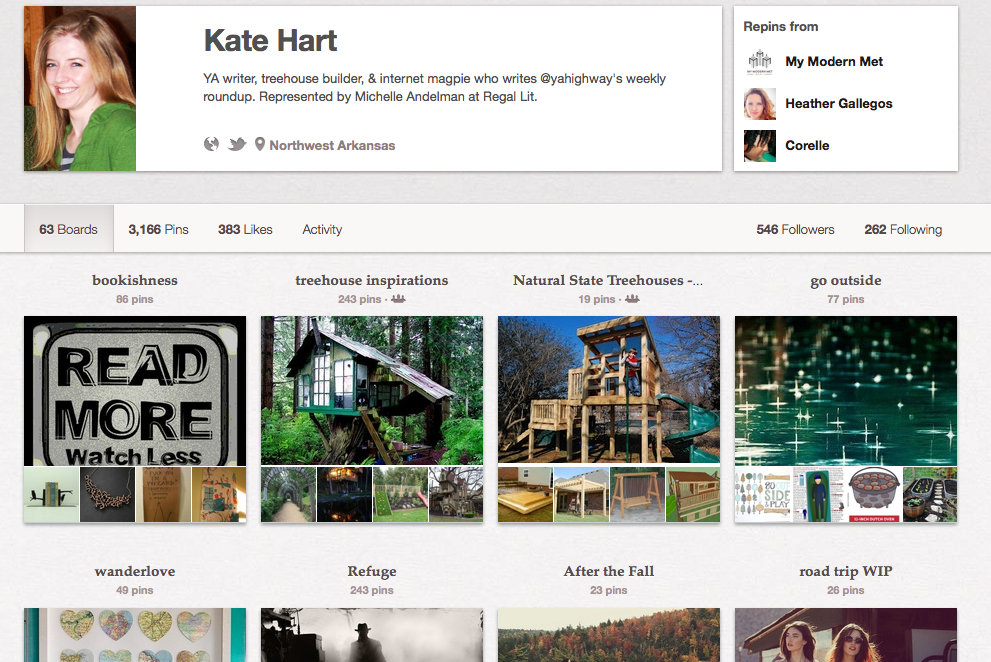Pinterest and using the visual web for authors

Pinterest. Apart from having a clever name, it's also one of the fastest growing social media networks on the web. It has 48.7 million users, and 70 percent of those users "have taken some type of action offline as a result of an interaction via the site."
How does it work?
Pinterest is like a digital bulletin board where you can "pin" images from anywhere on the web. Users organize the images into groups, called "boards," that are based around a theme. Images can be linked to their source or anywhere else on the web. Users can browse any board, Like or RePin images, or even leave comments.
A great example is the lead photo I used, from author Kate Hart. Her Pinterest board is wonderful. It's well organized, evokes a mood and makes you want to click on the images.

How can an author use Pinterest?
- Sense of place: Because my novel is set in San Francisco, I might create a board full of images of San Francisco. If people find my board because of an interest in that place, I can link those photos back to a description of my book that evokes a strong sense of place. This is the kind of diversification of reader outreach that can really help a new author find more readers. And if you are someone who has great illustrations or some of your poems, stories, or novel is actually about photography, paintings, landscapes, etc., it's a great place to find people who are interested in those things who are likely to be interested in your book.
- Author bio: Sometimes I feel like my author bio is kind of restrictive. I end up listing my accomplishments and can only have one box photo. On Pinterest, you can create a board that is your visual bio, adding 10 or 12 photos that make more of a montage of who you are, then embed that board into your author website. The result is a more diverse and nuanced picture of who you are.
- Cover design: It can be hard for an author to convey the kind of design, look & feel, and color palette to a cover designer. One of the disconnects is that authors tend to use words and designers are partial to images. Creating a "cover design mood board" for your cover designer to look at can be a great way to collect images that are roughly the kind of idea you're looking for for your cover. It makes a great complement to any kind of conversation and/or email descriptions you give to your cover designer.
- Be social about it: The whole idea of using a social media network is to interact with other people. In the case of Pinterest, you can connect with other bloggers, readers and authors through images. To do this, make sure that you are pinning images from beyond your own blog. Pinning images from book bloggers you like and will be contacting for a review can be a great way to start that relationship. Pinning the covers or other art from authors you read can be a great way to get to know active authors or let potential readers know, through book covers they may recognize, what kind of authors influence you or have similar writing styles. For example, here is a stellar list of YA authors, which would be a great place to start connecting if that's your genre.
- Story boarding and character sketching: When you are writing, it can be easy to end up with piles of notes and story lines that are hard to look at in one swoop. Pinterest can be a good place to stow images of what you picture scenes in your book as, what you picture your characters looking like, or anything that's in your book you want to have an inspirational visual sketch of. When you are done using them for inspiration, they can turn right around and use as an extra for you to share with readers when you do publish the book, either as a fun way for them to see what you were thinking or as a way to dig deeper into the characters they like.
For more ideas about how to use Pinterest as an author, check out Jane Friedman's great article.
Have you used Pinterest as an author? What has your experience been?
Images courtesy of Lead from Kate Hart's Pinterest page, Inner from TBLC

0 comments